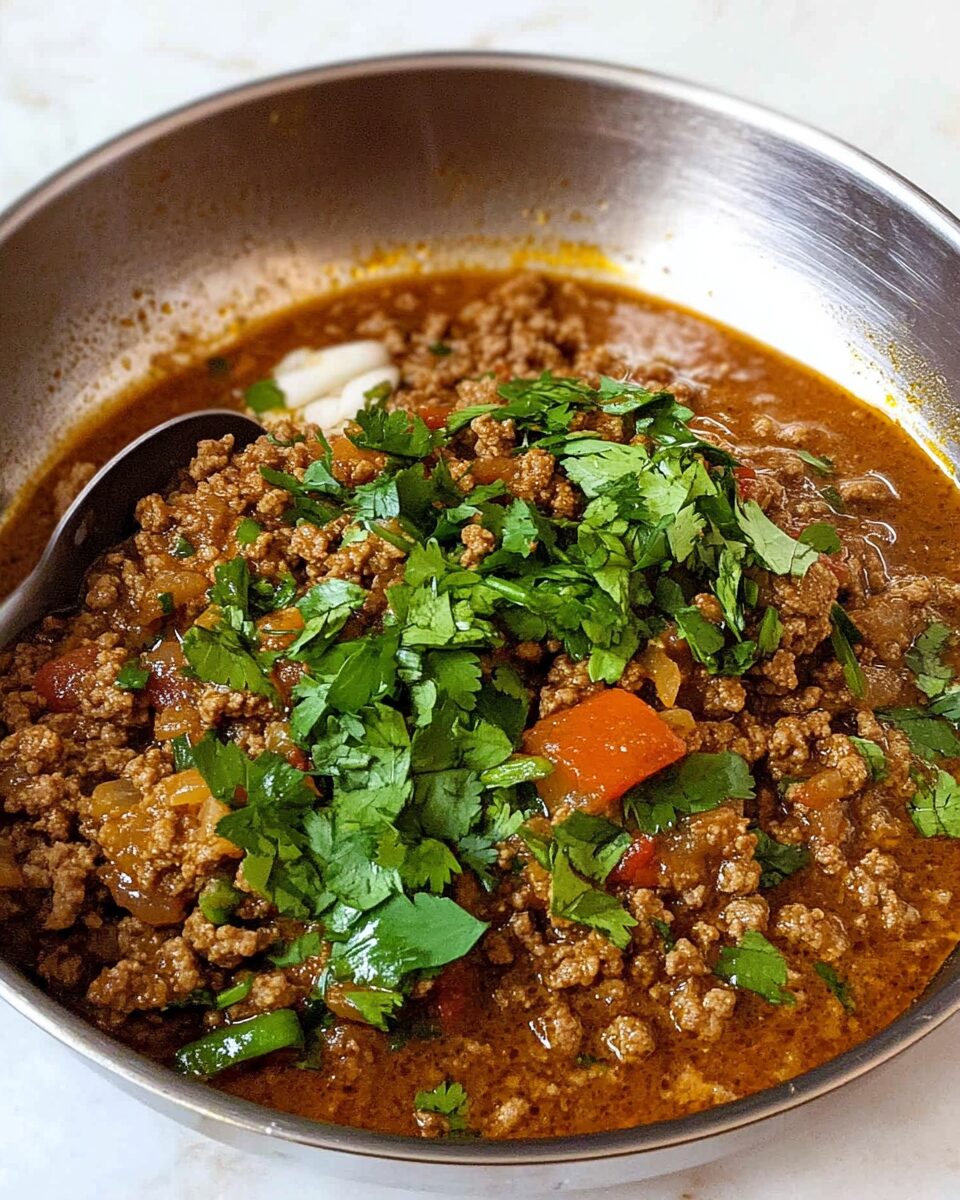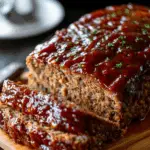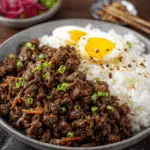The richness of this Ground Beef Curry comes from layers of warm, comforting spices that blend beautifully with tender beef and juicy tomatoes. It’s a one-pan wonder that fills your kitchen with irresistible aromas and hits the spot every time.
This recipe is incredibly versatile and quick to prepare, making it ideal for weeknight dinners. Serve it with steamed rice, roti, or naan for a complete, satisfying meal that feels like a hug in a bowl. Whether you’re new to curry or a seasoned spice lover, this dish delivers big flavor with minimal fuss.
Full Recipe
Ingredients:
-
1 lb (450g) ground beef
-
2 tbsp vegetable oil
-
1 large onion, finely chopped
-
2 garlic cloves, minced
-
1-inch piece of fresh ginger, grated
-
2 medium tomatoes, chopped
-
1/2 cup water
-
1 tsp ground cumin
-
1 tsp ground coriander
-
1/2 tsp turmeric
-
1/2 tsp cayenne pepper (optional)
-
1 tsp garam masala
-
Salt to taste
-
1/4 cup chopped fresh cilantro
-
Optional: 1 cup frozen peas or diced potatoes
Directions:
-
Heat the oil in a large skillet or sauté pan over medium heat.
-
Add chopped onions and sauté until golden brown.
-
Stir in garlic and ginger; cook for 1-2 minutes until fragrant.
-
Add chopped tomatoes and cook until they break down and form a thick paste.
-
Stir in cumin, coriander, turmeric, cayenne (if using), and salt. Cook the spices for 1 minute.
-
Add the ground beef and cook until browned, breaking it apart with a spoon.
-
Add water and bring to a simmer. Cover and cook for 10–12 minutes.
-
If using peas or potatoes, stir them in and cook until tender.
-
Sprinkle with garam masala and chopped cilantro. Stir well.
-
Serve hot with rice, naan, or roti.
Prep Time: 10 minutes | Cooking Time: 25 minutes | Total Time: 35 minutes
Kcal: 310 kcal | Servings: 4 servings
A Classic Ground Beef Curry That Brings Comfort to the Table
Ground beef curry is a staple in many South Asian and Middle Eastern kitchens, and for good reason. It’s hearty, flavorful, and endlessly adaptable to suit your pantry or dietary preferences. What makes this dish so beloved is its simplicity in preparation combined with its deep, layered flavors. With the right balance of spices, this dish transforms humble ground beef into a rich, aromatic meal that can stand proudly at the center of your dinner table.
The roots of this dish can be traced to traditional “keema” recipes, a term widely used in Indian and Pakistani cuisines to refer to minced meat cooked with spices. Over the years, variations of ground beef curry have evolved across cultures—sometimes made with peas, potatoes, or even boiled eggs—each lending its unique regional character to the dish.
Why Ground Beef Works So Well in Curry
Ground beef is an ideal choice for curry because it quickly absorbs the flavors of the spices and other ingredients. Unlike whole cuts of meat that may require long simmering times to become tender, ground beef cooks rapidly and remains juicy, making it perfect for weeknight meals. Its texture also allows for a rich, uniform integration of spices, tomatoes, onions, and herbs, creating a dish with depth and warmth in every bite.
Additionally, ground beef is widely available, affordable, and a favorite protein in many households. It offers a practical way to explore traditional Indian and Pakistani flavor profiles without needing to commit to hard-to-find ingredients or long cooking methods.
The Role of Spices in Ground Beef Curry
Spices are the heart of this dish. Commonly used ones include cumin, coriander, turmeric, cayenne pepper (if a bit of heat is welcome), and garam masala. Each spice plays a specific role—cumin adds earthiness, coriander lends citrusy brightness, turmeric brings warmth and color, and garam masala provides a fragrant finishing touch that ties everything together.
What’s especially great about homemade ground beef curry is that you can customize the spice level to your liking. Whether you enjoy your food mild or fiery, adjusting the proportions of chili powder or garam masala can help tailor the dish to your taste. You can even try adding cinnamon or cardamom for a sweet-spiced depth if you’re feeling adventurous.
Adaptability and Variations
One of the most appealing features of ground beef curry is how easy it is to adapt. You can add frozen peas, which provide a subtle sweetness and bright pop of color. Diced potatoes are another common addition, absorbing the curry’s flavors while giving the dish a heartier bite.
Some cooks enjoy adding yogurt or coconut milk for creaminess, transforming it into a more saucy, rich curry that pairs beautifully with naan or basmati rice. If you prefer a drier version (sometimes called “keema fry”), simply simmer the curry until most of the liquid evaporates and you’re left with a robust, thick mixture perfect for scooping with flatbread.
For a low-carb version, serve the curry over cauliflower rice or wrap it in lettuce leaves. You can also stuff it into a paratha for a handheld snack or use leftovers to top baked potatoes for a fusion twist.
What to Serve with Ground Beef Curry
This dish is traditionally served with basmati rice, roti, or naan, which helps soak up the flavorful sauce. A dollop of plain yogurt or a side of raita complements the spices with a cooling effect. Fresh salad with cucumber and red onions, lightly dressed with lemon juice, can also provide a crisp contrast to the warm, spiced meat.
For a complete meal, consider adding a lentil dal or a simple vegetable side dish like sautéed spinach or okra. Pickled onions, chutney, or papadums also make flavorful accompaniments and help enhance the experience.
Storage and Meal Prep Tips
Ground beef curry stores well, which makes it an excellent choice for meal prep. The flavors often deepen after a night in the fridge, making leftovers even tastier the next day. It keeps for up to 4 days in the refrigerator and can be frozen for up to 2 months in an airtight container.
To reheat, simply warm it in a pan over low heat, adding a splash of water if needed to loosen the sauce. This dish also freezes beautifully—store it in individual portions for a quick lunch or dinner solution when time is tight.
Is Ground Beef Curry Healthy?
Yes, it can be! When made with lean ground beef and lots of tomatoes, onions, and optional vegetables like peas or spinach, this dish becomes a well-rounded, nutrient-dense meal. It’s rich in protein, iron, and essential vitamins, especially when paired with whole grains like brown rice or millet.
To make it even healthier, you can substitute ground beef with ground turkey or chicken, use minimal oil for cooking, and bulk up the dish with extra veggies. Using homemade spice blends also helps you avoid the preservatives and sodium often found in store-bought curry sauces.
Cultural Significance and Comfort Factor
Ground beef curry holds a special place in the hearts of many home cooks because it’s tied to family meals, traditions, and comforting flavors passed down through generations. While every household might have its own variation, the essence of the dish remains the same: warm, deeply spiced, and made with love.
In many cultures, the act of preparing curry is a communal or family tradition. The smell of spices toasting, onions browning, and tomatoes reducing to a thick paste is not just part of cooking—it’s a sensory ritual that evokes memories and creates new ones.
Conclusion
Ground beef curry is much more than a quick dinner idea—it’s a celebration of flavor, tradition, and adaptability. It shows that with a few everyday ingredients and a handful of spices, you can create something extraordinary. Whether you’re new to Indian-inspired cuisine or looking for a reliable comfort meal, this dish fits the bill.
Its flexibility allows you to tailor it to your dietary needs, spice tolerance, and available ingredients. From busy weeknights to relaxed weekend cooking, ground beef curry delivers satisfaction in every spoonful. Pair it with your favorite sides, garnish with herbs, and enjoy a dish that never fails to bring warmth to the table.






